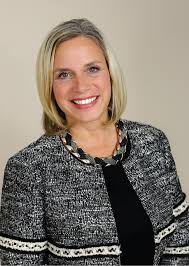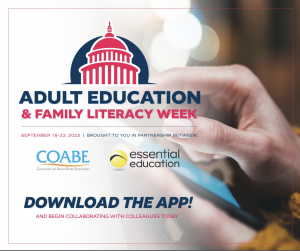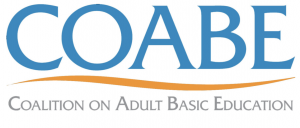National Adult Education and Family Literacy Week Amplifies Industry Achievements in Upskilling the Workforce
National Adult Education and Family Literacy Week Amplifies Industry Achievements in Upskilling the Workforce EIN News


Sharon Bonney, CEO of COABE
Low-cost programs offer high value gains for wide variety of adult learners, including High School Equivalency (HSE) and job training seekers.
More than 51.4 million Americans can’t read or write at the most basic level while 75.1 million lack basic math skills…”
— Sharon Bonney, CEO, COABE
National Adult Education and Family Literacy Week Amplifies Industry Achievements in Upskilling the Workforce
BRADENTON, FL, USA, September 7, 2023/EINPresswire.com/ — This year’s National Adult Education and Family Literacy Week (AEFL), September 18 – 22, 2023, includes in-person and virtual convenings of adult learners, community partners, business leaders, legislators, and friends of adult education to celebrate achievements in the field as well as to connect with legislators on the continuing need to increase adult education programs. Assistant Secretary at the U.S. Department of Education, Amy Loyd, will kick-off the week with a welcome message and discussion with Coalition on Adult Basic Education (COABE) leadership.
Adult Education Programs in the United States
- Adult education programs in the United States are funded through the Adult Education and Family Literacy Act (Title II) of the Workforce Innovation and Opportunity Act (AEFLA/WIOA), a federal law that aims to provide funding for various workforce development programs, including adult education that serves as a pipeline to the community college system for students.
- The AEFLA/WIOA programs offer extensive services, such as basic education, English language instruction, High School Equivalency (HSE) preparation, transition to postsecondary, and job training. The funding provided ensures that these programs are accessible to individuals who may not have the financial means to pursue education and training on their own.
“More than 51.4 million Americans can’t read or write at the most basic level while 75.1 million lack basic math skills, as well as the credentials and skills necessary to succeed in post-secondary education and the workforce,” noted Sharon Bonney, Chief Executive Officer of the Coalition on Adult Basic Education. “This is just one reason why adult education is so vital to our economy!”
Activities during Adult Education and Family Literacy Week
- Throughout Adult Education and Family Literacy Week, a variety of resources will be available including the unveiling of a new campaign and toolkit showcasing the value of High School Equivalency (HSE) credentials for the Adult Education System, adult learner showcases, legislative briefings, direct advocacy, and the Legislative Champions awards, honoring legislators who work to ensure funding and visibility for WIOA Title II funding for their contributions.
- Shaketta Thomas, COABE’s board president, quoted the American Action Forum which estimates that America is short an approximately 7.5 million private sector workers across all skill levels, noting that Adult Education programs contribute to solving these challenges by helping Americans move along the continuum in their educational journey to achieve basic skills and get prepared for career and college.
Accessibility and Benefits of Adult Education Programs
The adult education system delivers programs and is accessible through a variety of organizations, including community-based nonprofits, adult secondary schools, community colleges, and school districts. These programs also often provide digital equity services, teaching adult learners how to use computers and build digital skills.
Bonney also cited that Adult Education programs in high schools and adult schools, community colleges and community centers offer low cost, high value programs that upgrade the skill set of our citizens, including providing the High School Equivalency diploma to more than 75,000 learners annually.
About COABE
About COABE: COABE’s mission is to inspire educators so adults succeed and communities thrive. We provide leadership, professional development, advocacy, and communication services that encourage greater consciousness and cultural competency in our interactions with teachers, administrators, adult learners, and our partners. We are committed to using our platform and influence to celebrate, engage with, and listen to all adult education communities and diverse voices of our field. Learn more at COABE.org.
Contact Information
Anika Jackson
Full Capacity Marketing, Inc.
+1 310-567-0038
email us here
Visit us on social media:
SDGs, Targets, and Indicators in the Article
1. Which SDGs are addressed or connected to the issues highlighted in the article?
- SDG 4: Quality Education
- SDG 8: Decent Work and Economic Growth
- SDG 10: Reduced Inequalities
2. What specific targets under those SDGs can be identified based on the article’s content?
- SDG 4.6: By 2030, ensure that all youth and a substantial proportion of adults, both men and women, achieve literacy and numeracy.
- SDG 8.6: By 2020, substantially reduce the proportion of youth not in employment, education or training.
- SDG 10.2: By 2030, empower and promote the social, economic and political inclusion of all, irrespective of age, sex, disability, race, ethnicity, origin, religion or economic or other status.
3. Are there any indicators mentioned or implied in the article that can be used to measure progress towards the identified targets?
- Indicator for SDG 4.6: Literacy and numeracy rates among adults.
- Indicator for SDG 8.6: Proportion of youth not in employment, education, or training.
- Indicator for SDG 10.2: Social, economic, and political inclusion of all individuals.
Table: SDGs, Targets, and Indicators
| SDGs | Targets | Indicators |
|---|---|---|
| SDG 4: Quality Education | 4.6: By 2030, ensure that all youth and a substantial proportion of adults, both men and women, achieve literacy and numeracy. | Literacy and numeracy rates among adults. |
| SDG 8: Decent Work and Economic Growth | 8.6: By 2020, substantially reduce the proportion of youth not in employment, education or training. | Proportion of youth not in employment, education, or training. |
| SDG 10: Reduced Inequalities | 10.2: By 2030, empower and promote the social, economic and political inclusion of all, irrespective of age, sex, disability, race, ethnicity, origin, religion or economic or other status. | Social, economic, and political inclusion of all individuals. |
Behold! This splendid article springs forth from the wellspring of knowledge, shaped by a wondrous proprietary AI technology that delved into a vast ocean of data, illuminating the path towards the Sustainable Development Goals. Remember that all rights are reserved by SDG Investors LLC, empowering us to champion progress together.
Source: einnews.com

Join us, as fellow seekers of change, on a transformative journey at https://sdgtalks.ai/welcome, where you can become a member and actively contribute to shaping a brighter future.










